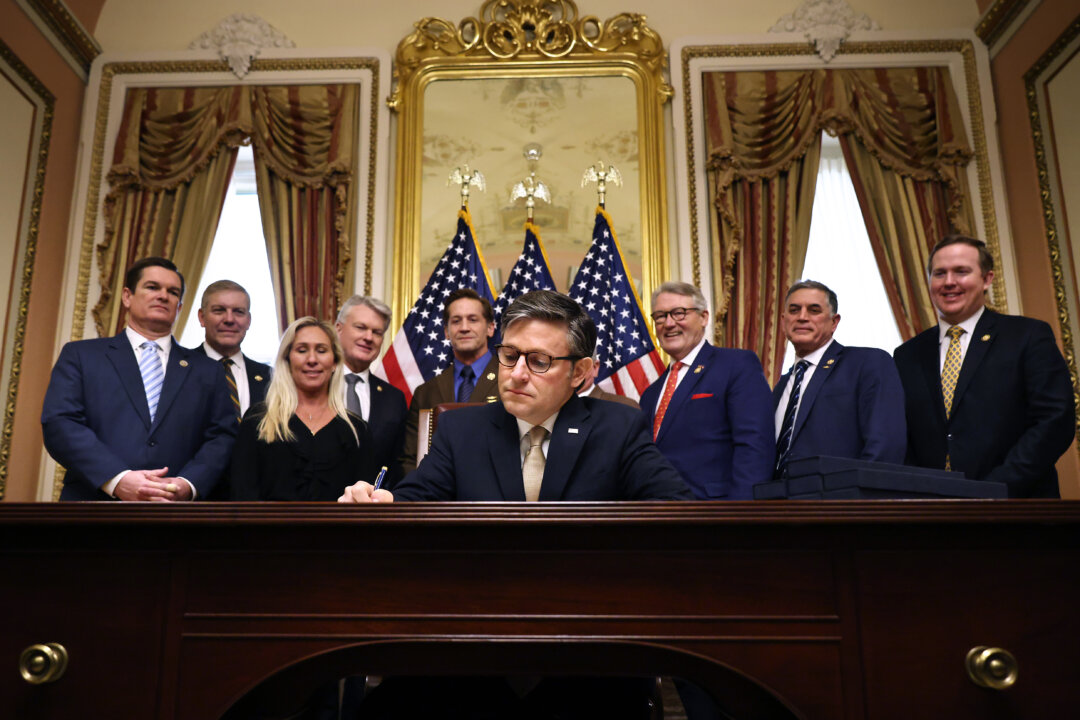The plan allocates several trillion dollars worth of spending to fund Trump’s political priorities. The Senate has passed a different plan.
WASHINGTON—The U.S. House of Representatives is expected to vote this week on a budget resolution for this fiscal year that will enable the passage of bills to fund the Trump administration’s America First policy initiatives.
The resolution for fiscal year 2025 authorizes over $5 trillion in new spending and directs committees of the House to make recommendations regarding how the money will be spent. It also calls for at least $1.5 trillion in spending cuts.
The largest share of spending, totaling $4.5 trillion, is allocated to the House Ways and Means Committee—intended for the extension of tax deductions that were part of the Tax Cuts and Jobs Act (TCJA) of 2017.
The measure also authorizes $100 billion for military spending, $200 billion for border security and immigration enforcement, and a separate $4 trillion increase in the federal government’s sovereign debt limit.
The House Rules Committee will consider the measure on Monday afternoon.
Separately, the Senate on Feb. 21 passed its own budget resolution—a limited version of the same plan, authorizing a $300 billion boost to border security and military spending—for the reconciliation process. It also provides for changes in energy policy, while being completely offset by cuts in mandatory spending.
Although President Donald Trump has endorsed the House’s version, lawmakers said the Senate’s plan is intended as a reserve option in case the House fails to pass its version of the resolution or the eventual bill to be drafted.
Trump, during the 2024 election, vowed to complete the construction of a wall along the border with Mexico, remove illegal immigrants physically present in the United States, and extend the TCJA’s provisions, among other promises. Each of these initiatives will require large amounts of money, which the U.S. Constitution requires Congress to appropriate. To that end, Republicans in Congress are using the reconciliation process to authorize such funding.
The reconciliation process is necessary amid unanimous Democratic opposition to Trump’s agenda. It allows Republicans to bypass Senate filibuster rules that mean support from 60 senators is needed to advance legislation.
After advancing their budget resolution through the House Budget Committee on Feb. 13, Republicans in the House intend to bring the resolution to the floor for a final vote, as confirmed by the office of House Majority Leader Steven Scalise (R-La.) to The Epoch Times.
Trump last week endorsed the House’s plan for one spending bill over the Senate’s two-bill version.
“The House Resolution implements my FULL America First Agenda, EVERYTHING, not just parts of it! We need both Chambers to pass the House Budget to ‘kickstart’ the Reconciliation process and move all of our priorities to the concept of, ‘ONE BIG BEAUTIFUL BILL,’” Trump wrote on his social media platform Truth Social.
Days later, the president said he’s still open to multiple bills as long as they add up “to the same thing.”
For weeks, the Senate and House have disagreed on the strategy to enact such funding. Currently, in the Senate, there is opposition within the Republican Conference to the House plan to potentially cut Medicaid funding in order to pay for TCJA extensions. Trump has maintained that Medicaid and Social Security won’t be cut, other than dealing with fraud, as part of any funding plan.
The Senate has proposed a two-bill plan, whereby the first reconciliation bill will address the less controversial issues of border security and military spending. The second bill, per that plan, would address taxation, the sovereign debt limit, and efficiency reforms to Medicaid.
“This budget resolution allows … $175 billion in total to implement President Trump’s border security agenda… [and] $150 billion to make our military more lethal. It also allocates up to $20 billion to be spent to modernize the Coast Guard,” Senate Budget Committee Chairman Lindsey Graham (R-S.C.), the Senate resolution’s sponsor, wrote in a statement after it was passed. “This approach provides money that we needed yesterday … Time is of the essence.”
The Senate’s plan has long been opposed by the House, where the Republicans’ one-seat majority entails a fragile consensus between fiscal conservatives and the rest of the conference. House Speaker Mike Johnson (R-La.) has repeatedly said that his conference can only, realistically, pass one reconciliation bill. Hence, the House resolution authorizes spending targets for all areas of focus—such as $4.5 trillion in tax cuts, and $4 trillion for the debt limit.
“The House budget resolution implements President Trump’s FULL America First agenda, not just parts of it with promises to come back later for the rest,” Johnson wrote on social media platform X. “We remain laser-focused on sending our bill to President Trump’s desk to secure the border, keep taxes low, restore American energy dominance, strengthen America’s military, and make government work better for all Americans.”
After the House’s action, the Senate will have the option of passing the House resolution instead of its own proposal, in order to begin the bill-drafting stage of the reconciliation process. A date for the vote has not yet been declared.

